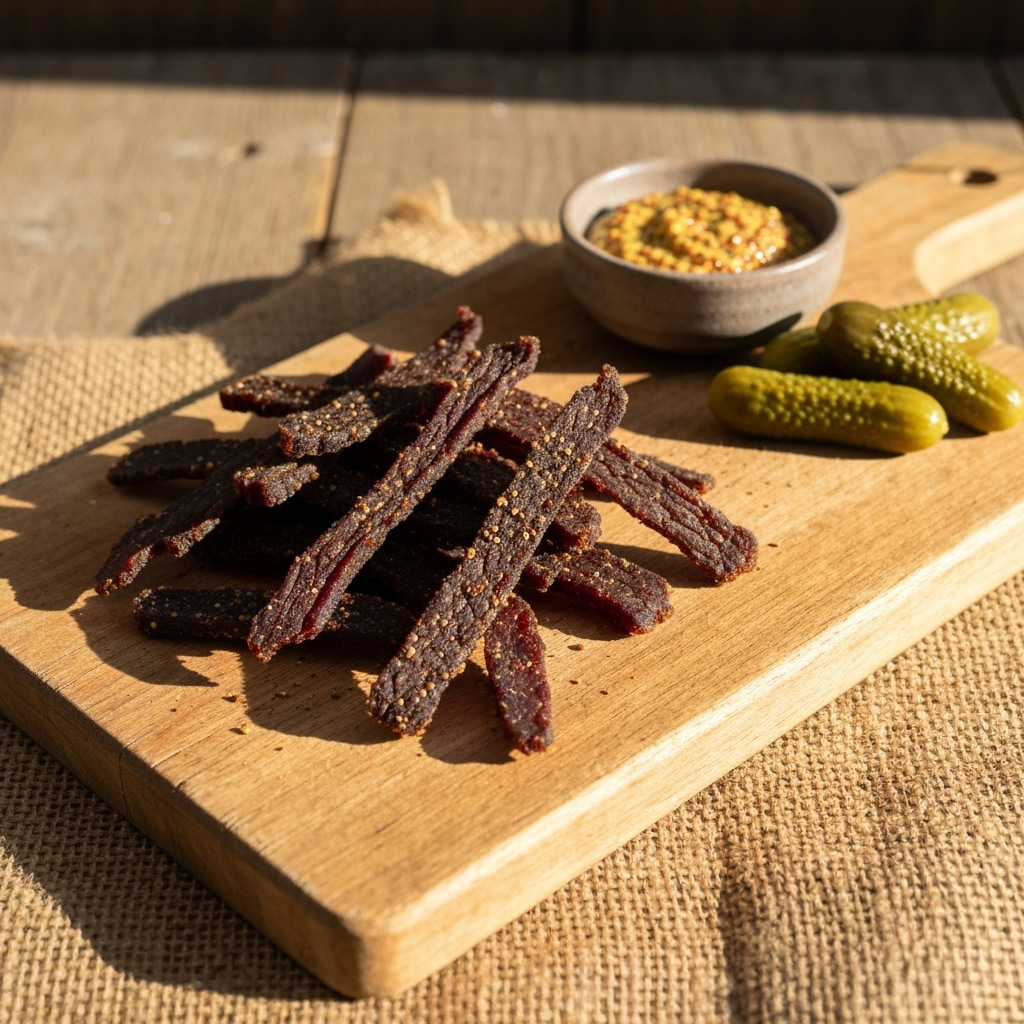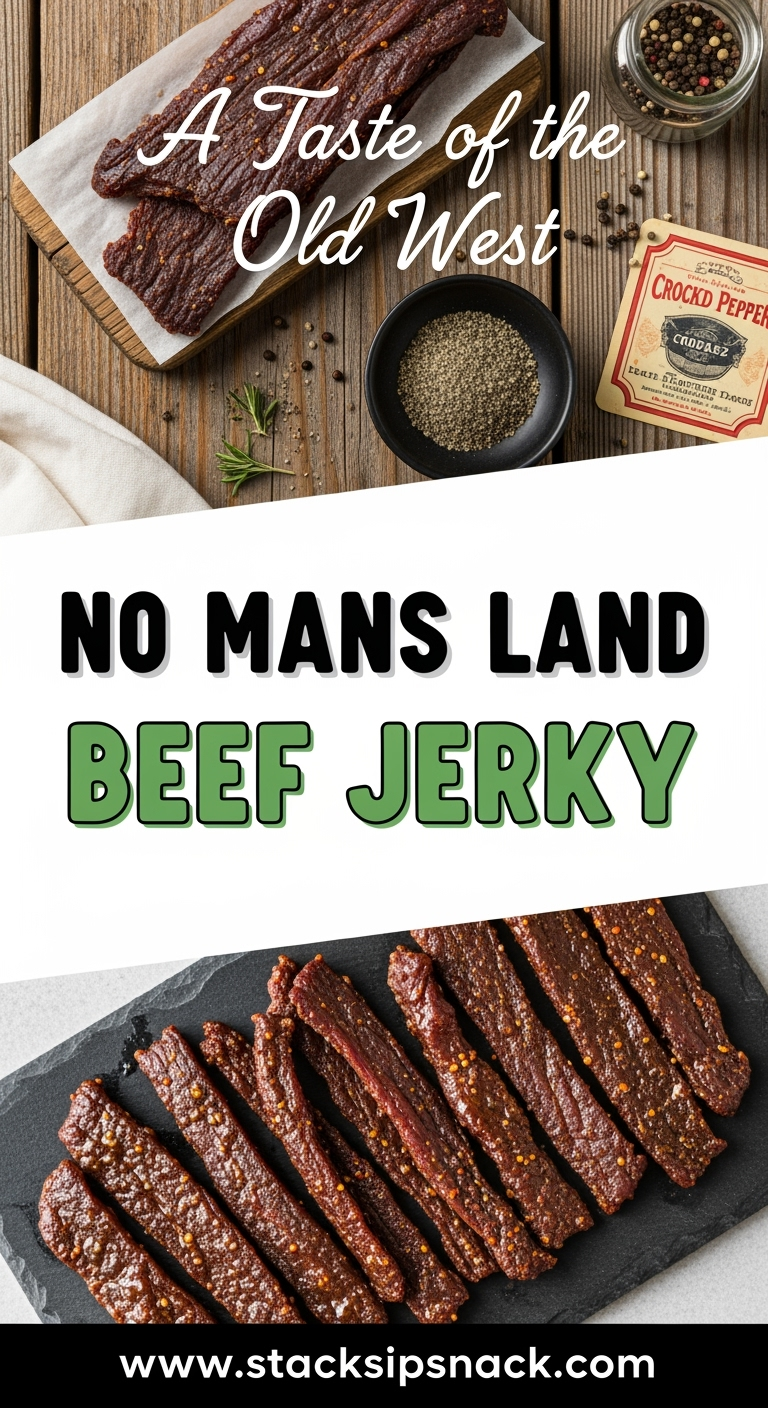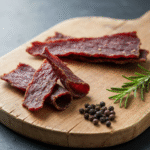There’s something deeply satisfying about making your own beef jerky—the slow, patient process, the rich aroma that fills your kitchen, and the reward of a chewy, savory snack you crafted yourself. But when I first set out to recreate the legendary No Mans Land beef jerky, I knew I wasn’t just aiming for any homemade beef jerky. I wanted that authentic, old west jerky flavor—the kind that tells a story with every bite.
My journey into traditional jerky recipe making started years ago on a camping trip with friends. We’d packed store bought jerky, but it was tough, overly sweet, and lacked character. One of the guys, a seasoned outdoorsman, pulled out a homemade batch his grandfather had taught him to make. It was transformative—deeply smoky, perfectly salted, with a chew that demanded attention. That memory sparked my obsession with mastering authentic western jerky at home.
No Mans Land beef jerky represents more than just a snack—it’s a piece of American frontier history. This style of jerky was born from necessity, using simple, natural ingredients jerky methods to preserve meat for long journeys. Unlike many modern versions loaded with sugar and artificial flavors, this recipe stays true to its roots. It’s a project that connects you to generations of cooks who valued simplicity, flavor, and preservation.
If you’ve ever wondered how to make beef jerky that stands apart from the commercial stuff, you’re in the right place. This guide will walk you through creating your own No Mans Land beef jerky recipe, from selecting the right cut of meat to achieving that perfect balance of smoke and spice. Whether you’re using a dehydrator, oven, or even a smoker, you’ll learn the techniques that make this old west jerky so special.
Table of Contents
No Mans Land Beef Jerky Ingredients
No Mans Land beef jerky starts with simple, high quality ingredients that let the natural beef flavor shine through. Here’s what you’ll need:
- 2 pounds lean beef (top round, bottom round, or flank steak work well)
- 1/2 cup soy sauce (or tamari for gluten-free)
- 2 tablespoons Worcestershire sauce
- 1 tablespoon liquid smoke
- 2 teaspoons black pepper, freshly cracked
- 1 teaspoon garlic powder
- 1 teaspoon onion powder
- 1/2 teaspoon cayenne pepper (adjust to taste)
- 1 teaspoon sea salt
Smart Substitutions:
- For a sweeter profile, add 1 tablespoon brown sugar or maple syrup
- Replace soy sauce with coconut aminos for lower sodium
- Smoked paprika can stand in for liquid smoke if needed
No Mans Land Beef Jerky Timing
- Prep time: 20 minutes (plus 4-12 hours marinating)
- Cook time: 4-6 hours
- Total time: 4.5-18 hours
While the active prep time is minimal, the magic happens during marinating and slow drying. This traditional jerky recipe isn’t rushed—it’s about developing deep flavor through patience.
Step-by-Step No Mans Land Beef Jerky Instructions
Creating authentic No Mans Land beef jerky requires attention to detail, but the process is straightforward once you understand the key steps.
1. Prepare the Beef
Start with partially frozen meat—it’s much easier to slice evenly. Trim all visible fat since fat doesn’t dry well and can cause spoilage. Slice against the grain into 1/4-inch thick strips. Consistent thickness ensures even drying.
2. Create the Marinade
Whisk together soy sauce, Worcestershire, liquid smoke, and spices in a medium bowl. The simplicity of this marinade reflects the old west jerky tradition—no complicated ingredients, just bold, honest flavor.
3. Marinate the Beef
Place beef strips in a large resealable bag or shallow dish and pour marinade over them. Massage gently to ensure every piece is coated. Refrigerate for at least 4 hours, though overnight (8-12 hours) delivers the most flavorful results for your homemade beef jerky.
4. Drain and Pat Dry
Remove beef from marinade and pat strips dry with paper towels. This step is crucial—excess moisture will steam the meat rather than dry it properly. Some traditional jerky recipes skip this, but trust me, drying the surface makes a significant difference in texture.
5. Arrange for Drying
Place strips in a single layer on dehydrator trays or oven racks, ensuring they don’t touch or overlap. Air circulation is key to even drying.
6. Dry the Jerky
In a dehydrator: Set to 160°F and dry for 4-6 hours. In an oven: Set to lowest temperature (usually 170°F) with door slightly ajar, drying for 4-6 hours. The jerky is done when it bends without breaking and has a firm, leathery texture.
7. Cool Completely
Transfer jerky to a cooling rack and let it come to room temperature before storing. This prevents condensation that could introduce moisture back into your finished product.
No Mans Land Beef Jerky Nutritional Information
Per 1-ounce serving (approximately):
- Calories: 70
- Protein: 11g
- Fat: 2g
- Carbohydrates: 1g
- Sodium: 480mg
This high-protein, low-carb snack provides sustained energy without the sugar crash of many commercial jerkies. The lean beef offers iron and B vitamins, while the simple marinade keeps unnecessary additives out of your snack.
Equipment Needed for No Mans Land Beef Jerky
You don’t need fancy equipment to make great jerky, but having the right tools makes the process smoother:
- Sharp chef’s knife or slicing knife
- Cutting board
- Measuring spoons and cups
- Large mixing bowl or resealable bags
- Dehydrator or baking sheets with oven-safe racks
- Paper towels
- Airtight containers for storage
While a dehydrator offers the most consistent results, your oven works perfectly fine for this traditional jerky recipe. Many authentic western jerky makers started with just an oven and basic kitchen tools.
Why You’ll Love This No Mans Land Beef Jerky Recipe
- Superior Flavor Control: Unlike store-bought versions, you decide the saltiness, spice level, and smokiness
- Cost Effective: Homemade beef jerky costs significantly less than premium store-bought brands
- No Hidden Ingredients: You know exactly what’s in your snack—no preservatives or artificial flavors
- Perfect Texture: Achieve your ideal chew, from slightly tender to toothsome and dry
- Satisfying Process: There’s genuine pride in creating something from scratch that nourishes and delights
Healthier Alternatives for No Mans Land Beef Jerky
This recipe already uses natural ingredients jerky enthusiasts appreciate, but you can make it even healthier with a few tweaks:
- Lower Sodium: Replace soy sauce with low-sodium tamari or coconut aminos
- Sugar-Free: Omit any sweeteners entirely—the original old west jerky contained none
- Different Proteins: While beef is traditional, you can apply the same method to venison jerky or even chicken jerky
- Spice Control: Reduce or eliminate cayenne for milder jerky, or add more for extra heat

Serving Suggestions for No Mans Land Beef Jerky
While jerky is fantastic on its own, it also plays well with other foods:
- Trail Mix Addition: Chop jerky into small pieces and mix with nuts, seeds, and dried fruit
- Charcuterie Boards: Include jerky strips alongside cheeses, crackers, and pickles
- Camping Trips: The portable nature makes it perfect for hiking and outdoor adventures
- Salad Topping: Crumble over greens for a protein boost instead of bacon bits
- Bloody Mary Garnish: A strip of jerky makes a savory stirrer for cocktails
Common Mistakes to Avoid with No Mans Land Beef Jerky
Even experienced cooks can stumble when making jerky. Here are the most common pitfalls:
- Skipping the Fat Trimming: Leaving fat on the meat will cause rancidity and uneven drying
- Rushing the Marinating: Less than 4 hours won’t develop the deep flavor this traditional jerky recipe deserves
- Overcrowding the Dehydrator: Pieces need space for air circulation—crowding leads to steamed, rather than dried, meat
- Testing Too Early: Jerky continues to firm as it cools—wait until completely cool to judge doneness
- Storing While Warm: Trapped heat creates condensation that can mold your batch
Storing Tips for No Mans Land Beef Jerky
Proper storage ensures your homemade beef jerky stays fresh and delicious:
- Room Temperature: Store in airtight containers or vacuum-sealed bags in a cool, dark place for up to 2 weeks
- Refrigeration: Extends freshness to 1-2 months
- Freezing: For long-term storage (up to 6 months), freeze in portion-sized bags
- Moisture Control: Add a food-safe silica gel packet to your storage container to absorb any residual moisture

No Mans Land Beef Jerky Conclusion
Making your own No Mans Land beef jerky connects you to a tradition of simple, honest cooking that values flavor and preservation over convenience and shortcuts. This authentic western jerky recipe delivers the robust, smoky character that commercial versions can only imitate.
The process itself becomes part of the reward—the anticipation as your kitchen fills with that incredible aroma, the satisfaction of creating something nourishing with your own hands, and the pride of sharing a snack made with care and attention.
Once you master this foundational beef jerky recipe, you might find yourself experimenting with different spice blends or even trying other proteins. The techniques you learn here apply to various beef jerky variations, and the knowledge will serve you well whether you’re making jerky at home or searching for that perfect store-bought alternative when time is short.
I’d love to hear about your jerky-making adventures! What variations did you try? How did your family react to your homemade creation? Share your experiences in the comments below, and don’t forget to tag @Stacksipsnack on Pinterest so we can see your delicious results. Happy jerky making
FAQs about no mans land beef jerky
Where is No Man’s Land beef jerky made?
No Man’s Land beef jerky is made in the town of Perkins, Oklahoma, USA. The company has been producing its jerky in this location for decades, sourcing its beef from the surrounding region.
What makes No Man’s Land beef jerky different?
No Man’s Land beef jerky is known for its old-fashioned, traditional style. It is a dry, heavily smoked jerky with a coarse, crumbly texture and a simple, robust flavor profile that comes from a straightforward recipe of beef, soy sauce, salt, and spices.
Is No Man’s Land beef jerky gluten-free?
No, traditional No Man’s Land beef jerky is not gluten-free. The original recipe uses soy sauce, which contains wheat. Always check the most current product packaging for the latest ingredient and allergen information.
How long does No Man’s Land beef jerky last?
Due to its low moisture content and traditional preservation methods, an unopened package of No Man’s Land beef jerky has a long shelf life. Once opened, it is best to consume it within a few days or store it in an airtight container to maintain freshness.
Where can I buy No Man’s Land beef jerky?
No Man’s Land beef jerky can be purchased directly from their official website. It is also available in various retail stores, particularly in the Midwest and through online retailers like Amazon.
What flavors of No Man’s Land beef jerky are available?
The company is famous for its Original flavor. They also offer other varieties such as Hot & Spicy, Peppered, and Teriyaki, providing options for those who prefer a bit more heat or a sweeter flavor profile.

No Mans Land Beef Jerky
- Total Time: 4.5-18 hours
- Yield: 2 pounds 1x
- Diet: Gluten Free
Description
Authentic old west beef jerky recipe with simple ingredients and traditional methods. This homemade jerky delivers deep smoky flavor and perfect chew without artificial additives.
Ingredients
- 2 pounds lean beef (top round, bottom round, or flank steak)
- 1/2 cup soy sauce (or tamari for gluten-free)
- 2 tablespoons Worcestershire sauce
- 1 tablespoon liquid smoke
- 2 teaspoons black pepper, freshly cracked
- 1 teaspoon garlic powder
- 1 teaspoon onion powder
- 1/2 teaspoon cayenne pepper (adjust to taste)
- 1 teaspoon sea salt
Instructions
- Prepare the Beef: Start with partially frozen meat for easier slicing. Trim all visible fat and slice against the grain into 1/4-inch thick strips.
- Create the Marinade: Whisk together soy sauce, Worcestershire, liquid smoke, and spices in a medium bowl.
- Marinate the Beef: Place beef strips in a large resealable bag or shallow dish, pour marinade over them, and massage gently. Refrigerate for at least 4 hours, preferably overnight.
- Drain and Pat Dry: Remove beef from marinade and pat strips dry with paper towels to ensure proper drying.
- Arrange for Drying: Place strips in a single layer on dehydrator trays or oven racks, ensuring they don’t touch or overlap.
- Dry the Jerky: In dehydrator at 160°F for 4-6 hours, or in oven at lowest temperature (170°F) with door slightly ajar for 4-6 hours. Jerky is done when it bends without breaking and has firm, leathery texture.
- Cool Completely: Transfer jerky to cooling rack and let come to room temperature before storing.
Notes
Store in airtight containers in cool, dark place for up to 2 weeks. For longer storage, refrigerate for 1-2 months or freeze for up to 6 months. Add food-safe silica gel packet to absorb moisture.
- Prep Time: 20 minutes
- Cook Time: 4-6 hours
- Category: Snack
- Method: Dehydrating
- Cuisine: American
Nutrition
- Serving Size: 1 ounce
- Calories: 70
- Sugar: 0g
- Sodium: 480mg
- Fat: 2g
- Saturated Fat: 1g
- Unsaturated Fat: 1g
- Trans Fat: 0g
- Carbohydrates: 1g
- Fiber: 0g
- Protein: 11g
- Cholesterol: 25mg
💬 Let’s Stay Connected!
For daily recipes, kitchen tips, and exclusive content, follow me on:
👉 Facebook for behind-the-scenes & community fun
👉 Pinterest for visual inspiration & meal ideas
👉 X (Twitter) for quick tips & trending recipes
📲 Join the flavor journey, your next favorite recipe is just a follow away!










